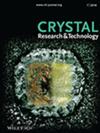Formation of a New Cocrystal Methyl‐4‐hydroxybenzoate:Urea and Its Structural and Thermal Properties
IF 1.9
4区 材料科学
Q3 CRYSTALLOGRAPHY
引用次数: 0
Abstract
A new cocrystal comprising two pharmaceutically important molecules methyl‐4‐hydroxybenzoate (p‐MHB) (C8H8O3) and carbonyl diamide (urea) [CO(NH2)2] is crystallized together for the first time through restricted solvent evaporation method at ambient conditions. The single crystal X‐ray diffraction analysis shows that the engineered cocrystal p‐MHB:urea (1:1) (C9H12N2O4) crystallizes in monoclinic system with centrosymmetric space group C12/c1. The internal structure analysis shows that the urea molecule with its unique ability forms hydrogen bonding network throughout the cocrystal system. Different orientations of the identified synthons form the networks via supramolecular connections such as C═O⋯H─O and C═O⋯N─H. Correlation between the internal molecular configurations in the unit cell, protruding molecular groups on different growth faces, and attachment energies of different crystal planes is studied. The Hirshfeld surface analysis shows that the higher percentage of overall interactions between the carbon and oxygen atoms at the outer surfaces of the cocrystal induces further incorporation of molecular aggregation and crystal growth. The 2D finger print plots infer that about 90.9% of the overall interactions are mainly due to the H bonds. Differential scanning calorimetry analysis reveals that the grown cocrystal undergoes an observable phase transition at 105.65 °C prior to its melting endotherm that peaks at 110.29 °C.一种新型共晶甲基- 4 -羟基苯甲酸脲的形成及其结构和热性能
用限制溶剂蒸发法在常温条件下首次结晶了一种由两种重要分子甲基- 4 -羟基苯甲酸酯(p - MHB) (C8H8O3)和羰基二胺(尿素)[CO(NH2)2]组成的新型共晶。单晶X射线衍射分析表明,p - MHB:尿素(1:1)(C9H12N2O4)共晶为中心对称空间群C12/c1的单斜晶系。内部结构分析表明,尿素分子以其独特的能力在整个共晶体系中形成氢键网络。识别的合成子的不同取向通过超分子连接形成网络,如C = O⋯H─O和C = O⋯N─H。研究了单晶胞内部分子构型、不同生长面上的突出分子群与不同晶面的附着能之间的关系。Hirshfeld表面分析表明,在共晶的外表面,碳原子和氧原子之间的总体相互作用百分比较高,导致分子聚集和晶体生长的进一步结合。二维指纹图谱显示,约90.9%的相互作用主要由氢键引起。差示扫描量热分析表明,生长的共晶在105.65°C时发生了可观察到的相变,在110.29°C时达到熔点。
本文章由计算机程序翻译,如有差异,请以英文原文为准。
求助全文
约1分钟内获得全文
求助全文
来源期刊
自引率
6.70%
发文量
121
审稿时长
1.9 months
期刊介绍:
The journal Crystal Research and Technology is a pure online Journal (since 2012).
Crystal Research and Technology is an international journal examining all aspects of research within experimental, industrial, and theoretical crystallography. The journal covers the relevant aspects of
-crystal growth techniques and phenomena (including bulk growth, thin films)
-modern crystalline materials (e.g. smart materials, nanocrystals, quasicrystals, liquid crystals)
-industrial crystallisation
-application of crystals in materials science, electronics, data storage, and optics
-experimental, simulation and theoretical studies of the structural properties of crystals
-crystallographic computing

 求助内容:
求助内容: 应助结果提醒方式:
应助结果提醒方式:


